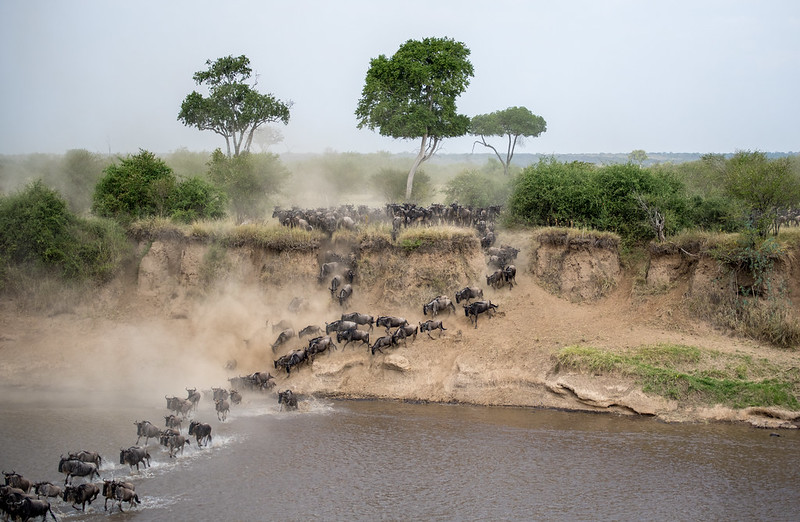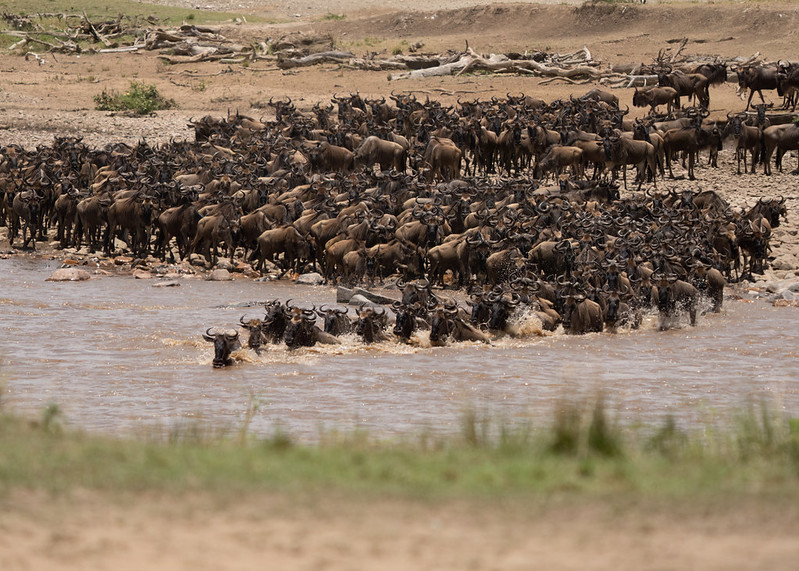The Wildebeests start arriving Kenya in June and by July- August, the entire plains of Mara have been occupied by the wildebeests, zebras and gazelles and its when mara crossing is in progress
Kakamega Forest National Reserve
Overview
Kakamega Forest National Reserve is a protected tropical rainforest located in the Western Province of Kenya, near the town of Kakamega. It is the only remaining tropical rainforest in Kenya and is considered an important ecological and biodiversity hotspot within the African continent. The kakamega forest reserve, protects a diverse tropical environment, the forest s a home to a variety of primates and top birding destination in Kenya. A variety of sought-after West African species live here and some of the bird species inhabit the forest jungle atmosphere.
Some of the key points about Kakamega Forest National Reserve:
Location:
Kakamega Forest National Reserve is situated in the Kakamega and Nandi counties of Kenya, in the western part of the country.
The forest is known for its rich biodiversity, including a variety of plant and animal species. It is home to numerous bird species, butterflies, insects, and several endangered mammal species.
The forest hosts a diverse array of flora, including over 380 species of plants, some of which are endemic to the region. The forest is also inhabited by various primates, such as colobus monkeys, blue monkeys, and olive baboons.
Conservation:
The Kakamega Forest is a protected area, managed by the Kenya Forest Service (KFS), to preserve its ecological significance and prevent further degradation.

Related Kenya Safaris
Activities In This National Park
Activities Visitors to Kakamega Forest National Reserve can engage in activities like birdwatching, nature walks, hiking, and photography to enjoy and appreciate the natural beauty and biodiversity of the forest.
Challenges:
The forest faces threats such as encroachment, logging, poaching, and habitat degradation. Conservation efforts are ongoing to address these challenges and ensure the long-term sustainability of the forest.
Kakamega forest is best experienced on foot where you get to explore the forest trails during the numerous activities including forest walking, Camping, hiking, primate watching, bird and butterfly watching, game viewing, village walks and rock climbing. Bird watching here I best done in the morning and evening where you will be accompanied by local tour guide who will take you through the various trails and help spot the different bird species for you.
There are also several mammal species living here including; bush pigs, giant forest hedgehogs, colobus monkeys, Debrazzar monkey and pottos. Several bird species seen here include; Blue Headed Bee Eater, Black Billed Turaco, Turner’s Eremomela, Grey parrot among others. Other attractions found here are the Snakes such as Black Lipped Cobra, Horned Viper, Gabon Viper and Forest Cobra among others.
Preserving Kakamega Forest is crucial for its biodiversity and the ecosystem services it provides to the local communities and the wider region. It also holds cultural and historical significance for the people of Kenya and those interested in the conservation of tropical rainforests.

Attractions In This National Park
Attractions in Kakamega Forest National Reserve: There are several attractions and attractions include; Bird watching, primate tracking, game viewing, walking trips, hiking, fishing on the river, camping, nature walks.
Kakamega forest Bird watching
Kakamega is the only remaining ascent forests in Kenya and bird watching is excellent all year round. Kakamega is bird watchers’ paradise with most of the forest bird species are often permanent inhabitants and can be seen all year round with Migratory birds seen in the forest from November to April. Kakamega Forest is a popular birdwatching destination located in western Kenya. It is renowned for its rich biodiversity, including a wide variety of bird species.
Birdwatchers and nature enthusiasts visit Kakamega Forest to observe and appreciate the diverse avian life it offers. Here’s some information about birdwatching in Kakamega Forest:
Kakamega Forest is home to over 400 bird species, making it a prime location for birdwatching. Some notable species include the African Blue Flycatcher, African Goshawk, Great Blue Turaco, African Shrike-flycatcher, and many more. There are several well-marked trails within Kakamega Forest that provide excellent opportunities for birdwatching. Birdwatchers can explore these trails to spot various bird species amidst the lush greenery and diverse habitats.
To enhance the birdwatching experience, guided tours are often available. Local guides are knowledgeable about the forest’s birdlife and can help identify and locate different bird species. They can also provide interesting facts and insights about the birds and their behavior
The best time for birdwatching in Kakamega Forest is typically during the dry months, from December to March and June to September. During these periods, the weather is generally pleasant, and bird activity is at its peak
Birdwatchers should bring essential equipment such as binoculars, a bird field guide for the region, a notepad, and a camera. Proper footwear and clothing suitable for outdoor activities are also important.
When birdwatching in Kakamega Forest, it’s important to follow responsible birdwatching practices. Avoid disturbing the birds or their habitats, maintain a respectful distance, and follow any guidelines provided by the local authorities or guides.
Accommodation options:
There are various accommodation options available near Kakamega Forest, ranging from lodges to guesthouses. It’s advisable to make reservations in advance, especially during the peak birdwatching seasons.
Engage with local birdwatching guides or naturalists to gain a deeper understanding of the forest’s ecosystem and the behavior of its bird species. Their expertise can significantly enhance your birdwatching experience
Remember to respect the environment, wildlife, and local communities while enjoying the breathtaking birdwatching experience that Kakamega Forest has to offer.
Kakamega forest Wildlife
Kakamega Forest is a tropical rainforest located in Kakamega County, in the western region of Kenya. It is the last remnant of the ancient Guineo-Congolian rainforest that once stretched across central Africa. The forest is renowned for its biodiversity and unique flora and fauna.
In terms of wildlife, Kakamega Forest is home to a diverse array of species, although it’s important to note that it primarily supports a rich variety of plant life. Some of the notable wildlife found in the forest includes:
Kakamega Forest is a haven for birdwatchers, boasting over 400 species of birds. This includes rare and endemic species such as the African Grey Parrot, Great Blue Turaco, and the Blue-headed Bee-eater
Various primate species inhabit the forest, including the endangered De Brazza’s monkey, black-and-white colobus monkeys, red-tailed monkeys, and blue monkeys.
The forest is abundant with diverse species of butterflies and insects, making it a fascinating destination for entomologists and nature enthusiasts.
Reptiles and Amphibians: The forest is home to a variety of reptiles and amphibians, including various snake species, chameleons, frogs, and toads.
The forest also supports smaller mammal species like bushbucks, mongooses, squirrels, and porcupines.
Kakamega Forest Trees Species
There over 300 tree species found in the reserve including Africa’s greatest hard and soft wood, Elgon teak, red stinkwood, stinkwood, several varieties of croton and Pouteria altissima .
Preservation efforts are in place to protect the biodiversity of Kakamega Forest, as it faces threats from deforestation, human settlement, and agricultural expansion. Conservation organizations and the Kenyan government work to raise awareness about the importance of preserving this unique and valuable ecosystem.
Visitors to Kakamega Forest have the opportunity to explore its natural beauty, observe wildlife, enjoy birdwatching, and engage in eco-tourism activities while promoting conservation efforts to sustain the forest’s delicate ecosystem.
Best Time To Visit
Best time to visit Kakamega Forest Reserve in Kenya: Kakamega Forest Reserve, located in Kenya, is a tropical rainforest and is a popular destination for ecotourism and nature enthusiasts. The best time to visit Kakamega Forest Reserve depends on your preferences and what you want to experience, as the weather and wildlife sightings vary throughout the year. Here’s a breakdown of the months and what you can expect:
- January to March:
This period is generally warm and dry, making it a good time for hiking and outdoor activities. Wildlife is easier to spot due to sparse vegetation. - April to June:
These months are part of the long rainy season, so expect frequent rain and lush greenery. Birdwatching is excellent during this time, but hiking may be more challenging due to the wet conditions. - July to September:
This is a good time to visit as the weather is generally mild and dry. The trails are in good condition, making hiking more enjoyable. Wildlife is still visible, and the forest is lush after the rains. - October to December
This period marks the short rainy season, with sporadic rainfall. The forest is vibrant and green, and there’s a chance to see migratory bird species. Hiking is enjoyable, although some areas may be a bit muddy.
The Kakamega forest can be visited all year round although the best time for most of the park activities is during the dry season. December and January are the drier month while June to August is the excellent time for bird watching safaris which is the breeding time for birds. April, May to September when you spot several butterfly species. Migrant birds are present from November to April.
How to get there
Request Quote
Fill in and send the safari request form, we shall respond as soon as we receive your message.
You can also reach us on Whats-app Number: +256753750983 for urgent requests.
Tour Highlights
- Day 1: Transferring from Nairobi to the Lake Nakuru
- Day 2: Lake Nakuru to Masai Mara National Reserve
- Day 3: A Full day in the Masai Mara
- Day 4: Transfer back to Nairobi
Why Book This Tour?
- Tour can depart on any day of the week.
- Tour can be customized
- Transportation in Landcruiser or minivan with pop-up for game viewing
- Suitable for solo travelers
Kenya National Parks
Masai Mara National Reserve
Read Our Reviews





